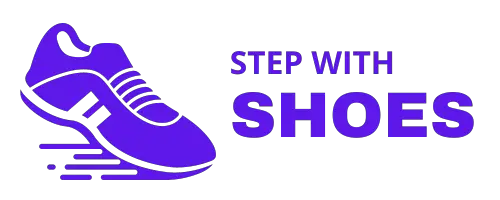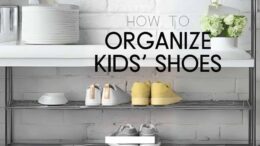To organize kids’ shoes, use labeled storage bins and shelves, ensuring each pair has a designated spot. Introduce a system that encourages kids to put their shoes back in their proper place after use.
Organizing kids’ shoes can be a daunting task, especially when you have little ones running around with shoes strewn everywhere. When shoes are scattered throughout the house, it becomes challenging to find matches, leading to frustration and time wasted. However, with a few simple strategies, you can create an organized and functional system for storing kids’ shoes.
By implementing labeled storage bins and shelves, each pair will have its designated spot, making it easier for both parents and children to find what they need. Additionally, introducing a fun and rewarding system that encourages kids to put their shoes back in their proper place after use will help instill organization habits from an early age.
The Importance Of Organizing Kids Shoes
Keeping your kids’ shoes organized is not just about having a neat and tidy space. There are several crucial reasons why organizing kids’ shoes is of utmost importance. Let’s explore these reasons:
Keep The Closet Clutter-Free
- A cluttered shoe closet can make it challenging to find the right pair of shoes for your child. By organizing their shoes, you can create a clutter-free space that allows for easy access and efficient selection.
- Having a clear and organized shoe closet also helps in maximizing space utilization. You can optimize the available storage area, making it easier to fit in all the shoes without any unnecessary mess.
- By keeping the closet clutter-free, your child will have a clean and visually appealing space. This can help them develop good organizational habits from an early age.
Easy Access And Visibility For Kids
- When shoes are well-organized, it becomes easier for kids to find the pair they need. Imagine the frustration of a child trying to locate their shoes in a messy closet while running late for school. A well-organized shoe system eliminates this frustration and saves valuable time.
- Kids often have difficulty identifying their shoes among a pile of similar-looking footwear. By organizing shoes in a visually clear manner, you can ensure that your child can easily differentiate and identify their own shoes.
- Visibility is key when it comes to organizing kids’ shoes. By arranging them in a way that each pair is visible, your child can quickly grab the shoes they want without having to search through the entire collection.
Save Time Getting Ready
- Organizing kids’ shoes can significantly reduce the time it takes to get ready in the morning. With an efficient system in place, your child can effortlessly find and put on their shoes, leaving more time for other essential morning tasks.
- A well-organized shoe closet eliminates the need for frantic searches and last-minute trips to find missing shoes. This saves you precious time and creates a stress-free morning routine for the entire family.
- By establishing a routine around organized shoes, you can teach your child valuable time management skills and responsibility for their belongings.
Challenges in Keeping Kids’ Shoes Organized
Despite the benefits of organized shoes, parents face a series of unique challenges when it comes to maintaining order in their children’s footwear collection. One of the primary challenges is constant growth. Children’s feet grow quickly, and this means they outgrow their shoes in a matter of months. Keeping up with sizing and ensuring that there’s always a pair of well-fitting shoes can be a perpetual struggle.
Another challenge is clutter. Kids tend to be less concerned with tidiness, and their shoes often end up scattered all over the house. Finding a missing shoe or keeping pairs together can become a daily scavenger hunt. Moreover, children may have a variety of shoe types, from sneakers to dress shoes, and organizing this diverse collection can be perplexing.
Preview of Key Steps and Tips for Organizing Kids’ Shoes
To address these challenges and achieve a well-organized shoe collection for your kids, this blog post will provide you with a comprehensive guide. We’ll cover everything from assessing your shoe collection and choosing suitable storage solutions to sorting and categorizing shoes effectively. You’ll also learn about the importance of cleaning and maintenance to prolong the life of your children’s shoes and the concept of seasonal rotation to keep their footwear appropriate for the weather.
In addition to practical steps, we’ll discuss creating a designated shoe station in your home and strategies for involving your kids in the organization process. We’ll even troubleshoot common issues and provide solutions to keep your shoe organization efforts on track.
Organizing kids’ shoes offers numerous benefits, from keeping the closet clutter-free to saving time and promoting independence in children. Implementing a system that provides easy access, visibility, and proper organization not only streamlines your daily routine but also teaches your child important life skills.
So, take the initiative today and create an organized shoe haven for your little ones.
Choosing the Right Storage Solutions
Various Storage Options
When it comes to organizing your kids’ shoes, selecting the right storage solutions is key to maintaining order and accessibility. Several options are available, each with its own advantages. Shelves are a popular choice as they provide a clear and open display of shoes. You can install wall-mounted shelves or use standalone shelving units to keep shoes organized by type or size. Another option is bins or baskets, which are versatile and can be placed in closets or under beds. They help keep shoes together and are especially useful for smaller shoe collections. Racks, such as over-the-door or floor-standing shoe organizers, are great for maximizing vertical space and are ideal for households with limited floor space.
When deciding on the right storage option, consider factors such as the number of shoes your child owns, the available space in your home, and your child’s age. Assess the functionality and aesthetics of each storage solution to ensure it aligns with your needs and preferences.
The Importance of Age-Appropriate Storage Solutions
Age-appropriate storage solutions are crucial when organizing kids’ shoes. Younger children might struggle with reaching shoes on high shelves or handling complicated shoe racks. For toddlers and preschoolers, consider using lower shelves or bins placed within their reach. Shoe organizers with colorful and playful designs can make the process of choosing and storing shoes more engaging for young children. As your child grows, you can gradually transition to more sophisticated storage solutions.
For older kids and teenagers, you can opt for more adult-like storage options, such as clear shoe boxes or modular closet systems. Make sure to involve your child in the decision-making process, taking their preferences and independence into account. Age-appropriate storage solutions not only help kids access their shoes easily but also encourage them to take responsibility for maintaining order.
Discussing Budget-Friendly Options
Organizing kids’ shoes doesn’t have to break the bank. There are plenty of budget-friendly storage solutions available that can help you keep shoes tidy without overspending. One cost-effective option is to repurpose items you already have, such as unused bookshelves, milk crates, or cardboard boxes. These DIY solutions can be personalized and painted to match your child’s room decor.
Another budget-friendly approach is to shop for affordable storage bins and clear shoe boxes at discount stores or online marketplaces. Look for sales, discounts, or bulk packages to get the best value for your money. Additionally, consider checking out thrift stores or second-hand shops for gently used storage furniture that can serve the purpose.
selecting the right storage solutions for organizing kids’ shoes involves assessing your child’s age, available space, and budget. By carefully considering your options, you can create an organized and functional shoe storage system that suits your family’s needs without breaking the bank.
Sorting And Categorizing
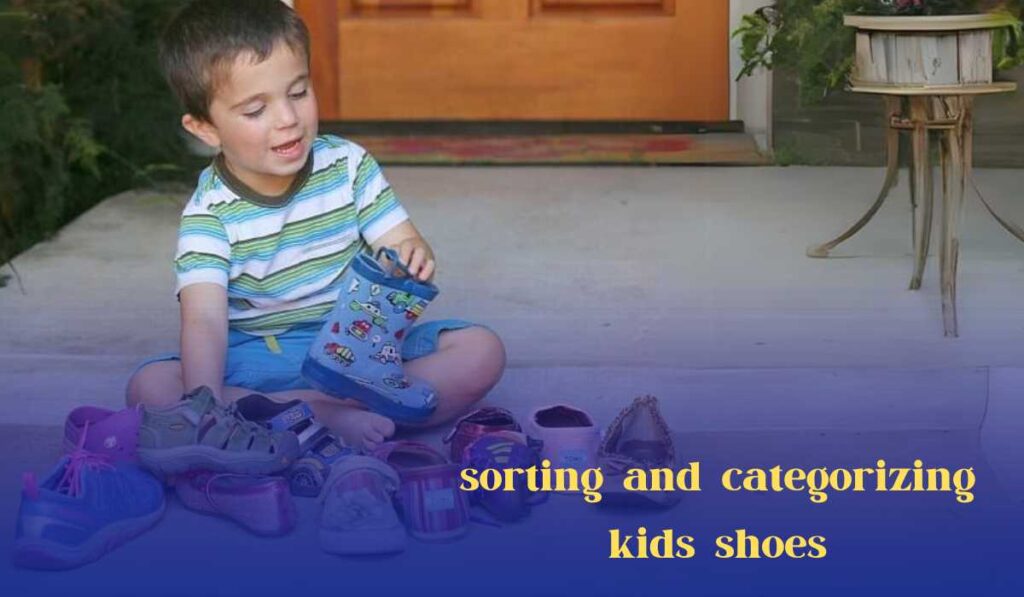
Group Shoes By Type And Season
When it comes to organizing kids’ shoes, sorting and categorizing are crucial steps in maintaining an organized space. By grouping shoes by type and season, you’ll not only make it easier to find the right pair but also extend the lifespan of the shoes.
Here are some key points to consider:
- Sort shoes by type: Start by separating the shoes into different categories based on their type. This can include categories like sneakers, sandals, boots, and dress shoes. By organizing them this way, you’ll be able to quickly locate the specific type of shoe your child needs for any occasion.
- Categorize shoes by season: Another effective way to organize kids’ shoes is by categorizing them based on the season. Allocate separate spaces or bins for summer shoes and winter shoes. This ensures that the appropriate shoes are readily available when the weather changes, making it easier for your child to find and wear the right shoes without a hassle.
- Use labeled storage bins: To keep the shoe organization system streamlined and efficient, consider using labeled storage bins. Label each bin according to the type and season of the shoes it contains. This not only adds a neat and organized touch but also allows your child to identify and retrieve the desired pair independently.
- Consider shoe racks for easy access: Shoe racks are a fantastic addition to any organizing system as they provide easy access to shoes. Consider investing in a shoe rack and dedicate specific sections to each type and season of the shoe. This arrangement allows your child to locate their shoes effortlessly, promoting independence and saving time during busy mornings.
By grouping your kids’ shoes by type and season and utilizing labeled storage bins and shoe racks, you can create a more organized and functional space for both your child and yourself. This system encourages independence and ensures that your child’s shoes are well-maintained and easily accessible whenever they need them.
Creating A Functional Entryway Shoe Station
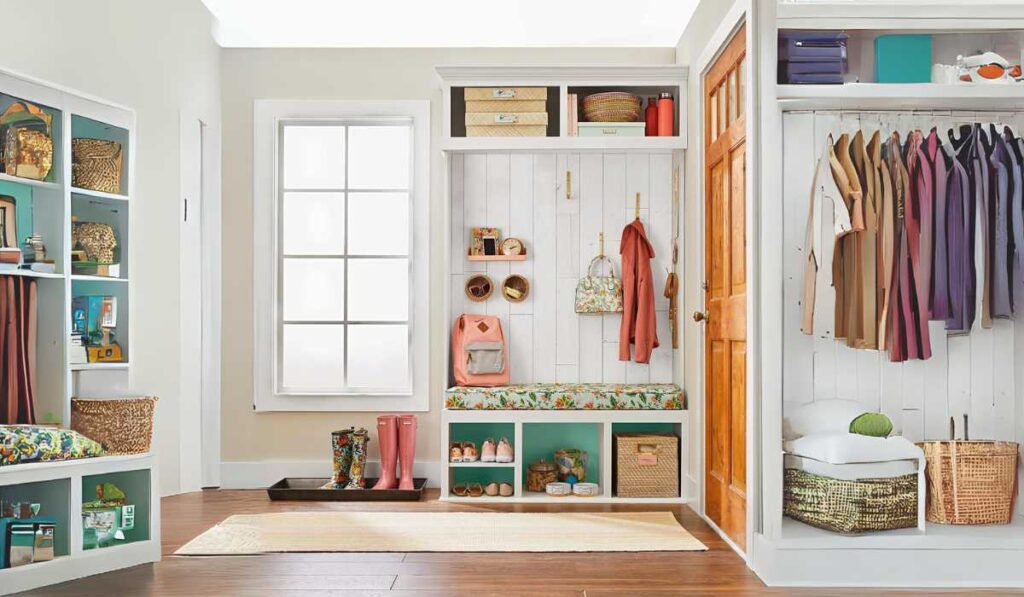
Having a designated area for your kids’ shoes can make a world of difference in keeping your entryway organized and clutter-free. A functional shoe station not only provides a dedicated space for storing shoes but also ensures easy access and convenience for your little ones.
Here’s how you can create an efficient shoe station in your entryway:
Choose A Designated Area For Shoes
- Identify a specific spot in your entryway that will serve as the designated area for shoes. This could be a corner, a nook, or even a section of a wall. The key is to choose a location that is easily accessible for both you and your children.
- Ensure that the designated area is free from any obstructions or hazards that may lead to accidents or tripping.
- Clear out any unnecessary items or clutter in the chosen area to optimize space and make room for shoe storage solutions.
Install Hooks Or Cubbies For Each Child
- Hooks or cubbies are an excellent way to keep individual pairs of shoes organized for each child. Assigning a specific hook or cubby to each child will not only help prevent mix-ups but also teach them responsibility for their belongings.
- Install hooks or cubbies at an appropriate height for your children to reach easily. Use labels or color-coded tags to further personalize and identify each child’s storage space.
- Hooks are ideal for hanging shoes with loops or straps, while cubbies can accommodate shoes of different sizes and styles. Consider using a combination of both to cater to the specific needs of your family.
- Ensure that the hooks or cubbies are securely fastened to the wall or the designated area to prevent any accidents or damage.
Add A Seating Bench For Convenience
- A seating bench near the shoe storage area can provide added convenience for you and your children. It offers a comfortable spot for putting on and taking off shoes, as well as a place to store bags or backpacks.
- Choose a bench that is sturdy and durable, capable of supporting the weight of both kids and adults. It should be at an appropriate height for your children to sit comfortably without assistance.
- Consider opting for a bench with built-in storage compartments or baskets underneath. This additional storage can be used to keep items such as shoe polish, shoe brushes, or extra socks, allowing for a neat and organized space.
Creating a functional entryway shoe station will not only help streamline your daily routine but also teach your children valuable organizational skills. With designated areas, hooks or cubbies, and a seating bench, you can effectively manage your kids’ shoe clutter and maintain an organized entryway for the whole family to enjoy.
Maximizing Space In The Closet
Are your kids’ shoes taking over your closet space? Don’t worry, we’ve got you covered! Follow these simple tips to maximize the space in your closet and keep those little shoes organized and accessible.
Utilize Hanging Shoe Organizers:
- Hanging shoe organizers are a game-changer when it comes to organizing kids’ shoes. Here’s why you should consider them:
- They help free up valuable floor space in the closet.
- Hanging shoe organizers come in various sizes and styles, allowing you to choose the one that works best for your needs.
- You can easily find the right pair of shoes without rummaging through a messy pile.
- These organizers are not only great for shoes but can also be used to store other small accessories like socks or even toys.
Invest In An Adjustable Closet System:
- An adjustable closet system is a must-have for organizing kids’ shoes efficiently. Here’s why you should consider investing in one:
- The adjustable shelves and rods can be customized according to the size of the shoes, allowing you to make the most of the available space.
- You can create designated sections for different types of shoes, making it easier for your little ones to find what they need.
- These systems often come with additional storage features such as drawers or baskets, providing even more space-saving options.
- As your kids grow, you can easily adjust the system to accommodate their changing needs.
Consider Utilizing Over-The-Door Shoe Racks:
- Over-the-door shoe racks are another excellent option for maximizing space in the closet. Here’s why you should give them a try:
- These racks hang over the back of the closet door, utilizing unused vertical space.
- They are easy to install and remove, making them a convenient choice.
- Over-the-door shoe racks come in various sizes, allowing you to choose one that suits your storage needs.
- They provide quick and easy access to your kids’ shoes, saving you time and effort when getting them ready.
So, there you have it! By utilizing hanging shoe organizers, investing in an adjustable closet system, and considering over-the-door shoe racks, you can maximize the space in your closet and keep your kids’ shoes organized and easily accessible. Stay tuned for more tips on how to organize kids’ shoes efficiently!
Teach Your Kids To Maintain Order
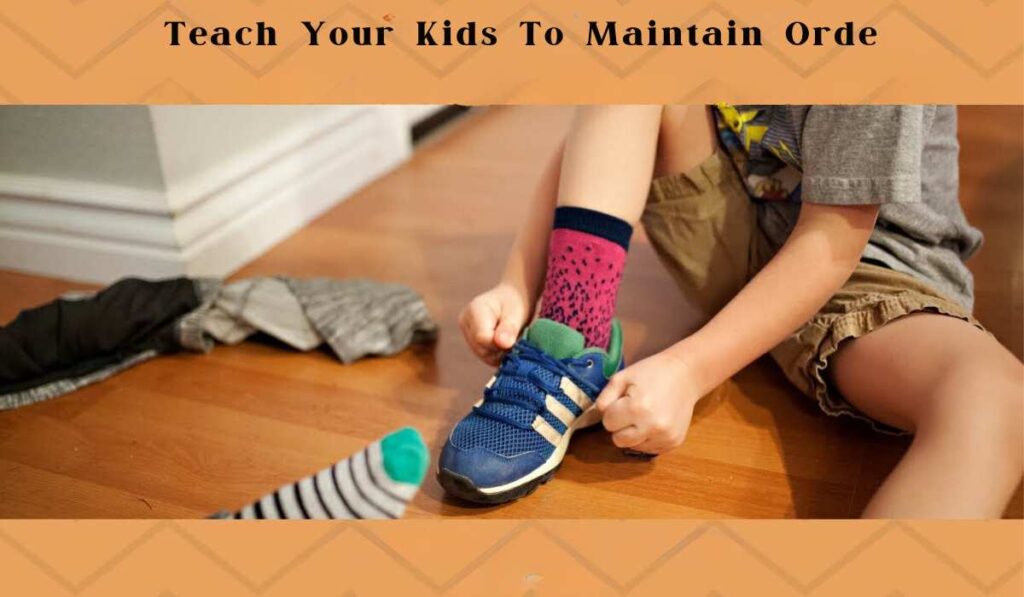
Establish a routine for putting shoes away:
- Create a designated spot for the shoes, such as a shoe rack or a basket, where your kids can easily access and store their shoes.
- Set a specific time each day for them to put their shoes away. This helps establish a routine and makes it easier for them to remember.
- Make it a habit to put shoes away immediately after taking them off. Encourage your kids to do this consistently.
Use visual cues to guide them:
- Use labels or pictures to indicate where each type of shoe should be placed. For example, you can have a label for sneakers, sandals, and boots. This helps your kids easily identify where each pair of shoes belongs.
- You can also use colored bins or boxes for each child to differentiate their shoes. This makes it more fun and visually appealing for them.
Make it a fun and rewarding experience:
- Turn shoe organization into a game. Challenge your kids to see who can put their shoes away the fastest or in the most creative way.
- Use a reward system to motivate them. For example, they can earn points or stickers for consistently putting their shoes away. Once they reach a certain number of points, they can choose a small prize.
Remember, teaching your kids to maintain order with their shoes is not only about keeping things tidy but also about instilling good habits and responsibility. By establishing a routine, using visual cues, and making it enjoyable and rewarding, you can help your kids develop a sense of organization and pride in taking care of their things.
Troubleshooting Common Issues
Addressing Common Problems like Mismatched Shoes and Clutter
When it comes to organizing kids’ shoes, some common issues can drive parents up the wall. Mismatched shoes are a familiar headache. Kids often remove their shoes in a hurry, and locating the matching pair can feel like a daily scavenger hunt. Additionally, the perpetual challenge of keeping shoes in order can lead to clutter. Shoes can pile up by the door, get left in various rooms, or simply create chaos in closets.
Providing Solutions and Tips for Dealing with These Issues
To tackle the issue of mismatched shoes, consider creating a designated area for shoe storage near the entrance of your home. Install hooks, cubbies, or a shoe rack for each family member. Encourage kids to place their shoes in their designated spot immediately upon entering the house. This simple practice not only keeps shoes organized but also reduces the chances of mismatched pairs.
To address clutter, establish a daily or weekly shoe clean-up routine. Dedicate a few minutes to gather all the stray shoes and put them back in their designated storage spaces. Make it a family activity to involve everyone in maintaining order. You can also assign each child the responsibility of organizing their shoes, teaching them valuable life skills and responsibility.
Sharing Reader-Submitted Success Stories or Ideas
To provide additional inspiration and solutions, consider sharing reader-submitted success stories or ideas within your blog post. Invite your readers to share their own experiences in organizing their kids’ shoes. Some may have unique strategies or creative storage solutions that have worked wonders for them. These real-life examples can offer valuable insights and relatable solutions for your audience.
By addressing common issues like mismatched shoes and clutter and offering practical solutions along with reader-submitted success stories, you’ll provide your readers with a well-rounded and informative guide to effectively organizing their children’s shoes.
Donating And Discarding Outgrown Shoes
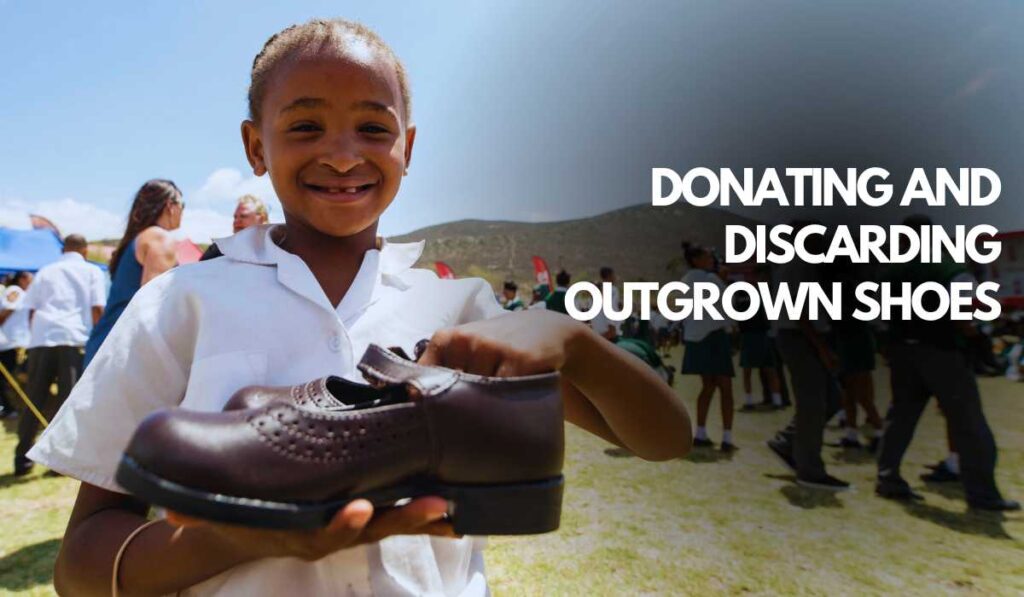
Regularly Assess Shoe Sizes And Condition
- Keep track of your child’s growth: Children’s feet can grow quickly, so it’s important to regularly measure their shoe size. Check their size every few months to ensure they’re wearing shoes that fit properly and comfortably.
- Inspect the condition of shoes: As kids are constantly on the move, their shoes can take quite a beating. Regularly assess the condition of their shoes to see if they’re worn out or damaged. Look for signs of excessive wear, including worn-out soles, holes, or loose stitching.
Donate Gently-Used Shoes To Charity
- Find a local charity: Look for local charities or organizations that accept gently used shoes for donation. Research their guidelines and find out if they have any specific requirements for accepting donations.
- Clean and sort shoes: Before donating, make sure the shoes are clean and in good condition. Wipe them down and remove any dirt or debris. Sort the shoes by size to make it easier for the charity to distribute them to those in need.
- Consider donation events: Some organizations hold specific events or drives for collecting shoes. Keep an eye out for these events in your community and take advantage of the opportunity to donate your child’s outgrown shoes.
Recycle Worn-Out Shoes Responsibly
- Find recycling programs: Look for recycling programs that accept worn-out shoes. Some organizations collect old shoes for recycling and repurposing. Research local options or check with shoe brands that offer recycling initiatives.
- Separate shoes from regular recycling: Don’t throw worn-out shoes in with your regular recycling. They may require special processing or need to be recycled through specific programs. Check with your local recycling center for guidance on how to dispose of them properly.
- Explore creative upcycling ideas: If recycling isn’t an option, get creative with repurposing the shoes. Turn them into planters, use them for storage, or even transform them into fun DIY projects. There are plenty of upcycling ideas available online to give your old shoes a new lease on life.
Regularly assessing shoe sizes and conditions will ensure your child always has comfortable footwear. Donating gently-used shoes allows others to benefit from them while recycling worn-out shoes reduces waste and helps the environment. By practicing these tips, you can efficiently organize your kids’ shoes while making a positive impact.
Frequently Asked Questions For How To Organize Kids Shoes
How Can I Organize Kids’ Shoes In A Small Space?
To organize kids’ shoes in a small space, you can use shoe organizers that hang on the back of the door or create a designated shoe rack near the entrance. Another option is to use clear plastic bins labeled with each child’s name to keep the shoes organized and easily accessible.
What Are Some Creative Ways To Organize Kids’ Shoes?
There are several creative ways to organize kids’ shoes. You can repurpose a bookshelf to create a shoe display, use a ladder as a shoe rack, or even hang a curtain rod with s-hooks to hang shoes and keep them organized.
These unique solutions not only save space but also add a decorative touch to the room.
How Often Should I Organize My Kids’ Shoes?
It is recommended to organize your kids’ shoes at least once every season or every six months. This ensures that you can declutter, reassess what shoes still fit, and make necessary adjustments to the storage system. The regular organization helps maintain order and prevents overcrowding in the shoe storage area.
Conclusion
Organizing kids’ shoes can be a challenging task but with the right strategies and systems in place, it can become a manageable and even enjoyable process. By implementing a few key steps, such as decluttering regularly, using storage solutions that are both functional and visually appealing, and involving children in the organization process, parents can create a harmonious and efficient shoe storage system.
Additionally, considering the unique needs and preferences of each child can help tailor the organization’s approach to their specific requirements. Remember, maintaining an organized and tidy shoe area not only saves time and reduces stress but also teaches children valuable life skills of responsibility and cleanliness.
So, why wait? Start implementing these tips today and watch as your kids’ shoe collection becomes a streamlined and organized space, making chaotic mornings a thing of the past. Happy organizing!
